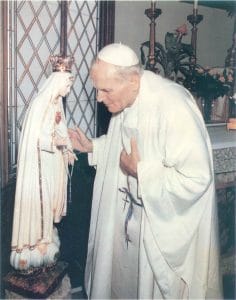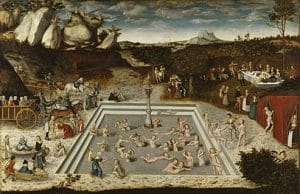CS Lewis once described modernity as being inhabited by “men without chests.” His pithy characterization highlights the fact that men no longer are educated to have a healthy emotional life. Lewis describes how in reviewing an elementary textbook, he came across a description of a waterfall as “sublime”. The authors insist that the speaker is “not making a remark about the waterfall, but a remark about his own feelings.” Lewis is concerned that such language, even in what appears to be a mere throwaway remark, betray a certain universal prejudice towards sentiments as nothing more than private feelings that have no objective basis in reality. Devoid of any real meaning attached to emotions, modern man suffers from a shrinking of his heart.
Lewis gives a sketch of man as having three parts: head, belly, and chest. By head he is referring to our spiritual faculties and by belly our bodily sensations. For most of us, that would be a sufficient description. But in order to be more than mere parts, they must be an integrated whole—they must be connected in the middle by the chest. To ignore the chest is literally disintegrating, you might even say dehumanizing. “It is by this middle element that man is man; for by his intellect he is mere spirit and by his appetite a mere animal.” It is the heart that makes humanity unique and it is through its proper integration that we become fully human.
The heart is the “place” where man’s hybrid nature meets and where man is most properly himself. But most of us have learned to be suspicious of our own hearts—and rightly so. But we cannot remain masters of suspicion without doing great harm to ourselves. We must confront this suspicion head on if we are to be authentically happy. After all happiness is not just a feeling, but a happiness that isn’t felt isn’t true happiness either.

Lewis thought part of the problem was in education. Although he doesn’t go into details about a proper pedagogy, it most certainly would begin by defining what we mean are talking about when we speak of the Heart. For modern man, the heart is really the place where our feelings reside. But this is far vaguer and narrower than the classical and Biblical notion of the heart. There are different kinds of feelings that we experience and these feelings are on different levels according to the unique powers of the human soul. There are the mere vegetative feelings like hunger and thirst. There are the animal feelings like contentment and anger. Finally, there are the spiritual feelings like peace and joy. When we speak of a heart that is fully alive, then we are speaking about a heart that has the capacity for the animal feelings (under the control of reason and will) and the spiritual feelings.
Men without Chests
At the end of his first chapter in The Abolition of Man, Lewis sums up the modern dilemma as follows: “We make men without chests and expect of them virtue and enterprise. We laugh at honor and are shocked to find traitors in our midst. We castrate and bid the geldings be fruitful.” His point is that without a healthy emotional life, we will never be able to be virtuous—it is like asking a castrated horse to reproduce. Notice what he is saying—neither the Stoic nor the Sentimentalist can be truly virtuous. To see why this is we need to reflect briefly upon the nature of virtue and its relationship with the emotions.
Temperance and fortitude and all their sub-virtues are ordered to the proper use of our emotions, or to use a more Thomistic term, the concupiscible and irascible passions. Notice the italics are use. Our emotions are not something that are to be killed or to be allowed to run free, but something that, when properly put to use, enable us to enjoy the good.
An example will help. All too often we hear “Courage is not the absence of fear; it is the making of action in spite of fear.” This is not the virtue of courage. The truly courageous person does not feel fear, but daring. Daring, when moderated by courage, gives him a motor by which he can energetically fight against the evil he must not avoid. Without it, he will succumb to fear or only fight back only weakly.
Virtue conditions the passions to act in accord with reason. When the courageous man is faced with evil, he does not need to deliberate or wait to stir up daring, it is automatically conditioned to arise in the face of some threat. In fact it may arise before he is even conscious of a threat and act as an alarm for the person.
Passions not only make the act easier then, but also make it better. St. Thomas says that when the passions are involved in a morally good act then it makes the act more meritorious. This is because the entire person—head, heart and hands—is involved in the act as opposed to simply white knuckling it. White knuckling is still good but doing so fervently is better. The less interior resistance we have to doing the good, the better the action is. So, despite popular misconceptions, there are moral reasons why we should be emotionally healthy as well.
Feeding Our Nature
Returning to Lewis’ point, education in the emotions is important because it is the thing that makes virtue easier. But this education must be aimed not so much on the feeling, but on the object that invokes the feeling. This cannot be emphasized enough. As long as the student is focused on the waterfall and not on the pleasure of the feeling of awe or wonder that can only be described as “sublime” he is focused on the good before him. The minute he turns to the pleasure as his focus, the pleasure is gone and the object is deemed boring. But if he remains focused on the object, he can learn to contemplate it to find out why it evokes such a response and if the response is, in fact, the appropriate one. This is one of the reasons why we must always protect and promote children’s capacity to wonder.
It is by taking in reality that they begin to grow in self-knowledge as well. Combined with education from parents especially, the child learns that there are right and wrong emotions. The right and wrongness depends upon the object that causes it. A young girl touching a cobra because she is charmed by it, needs to be shouted at so that she associates fear with it instead. All too often parents attempt to diffuse children’s emotions rather than guide them. This only causes moral problems later on down the road as Lewis points out “By starving the sensibility of our pupils we only make them easier prey to the propagandist when he comes. For famished nature will be avenged and a hard heart is no infallible protection against a soft head.”

















